
Tarot is a pack of playing cards, used from at least the mid-15th century in various parts of Europe to play card games such as Tarocchini. From their Italian roots, tarot-playing cards spread to most of Europe, evolving into a family of games that includes German Grosstarok and modern games such as French Tarot and Austrian Königrufen. In the late 18th century French occultists made elaborate, but unsubstantiated, claims about their history and meaning, leading to the emergence of custom decks for use in divination via tarot card reading and cartomancy. Thus, there are two distinct types of tarot packs in circulation: those used for card games and those used for divination. However, some older patterns, such as the Tarot de Marseille, originally intended for playing card games, are also used for cartomancy.

The Rider–Waite Tarot is a widely popular deck for tarot card reading, first published by the Rider Company in 1909, based on the instructions of academic and mystic A. E. Waite and illustrated by Pamela Colman Smith, both members of the Hermetic Order of the Golden Dawn. Also known as the Waite–Smith, Rider–Waite–Smith, or Rider Tarot, the deck has been published in numerous editions and inspired a wide array of variants and imitations. Estimates suggest over 100 million copies of the deck circulate across over 20 countries.

The Ace of Cups is a card used in Latin-suited playing cards. It is the ace from the suit of cups. In Tarot, it is part of what card readers call the "Minor Arcana", and as the first in the suit of cups, signifies beginnings in the area of the social and emotional in life.
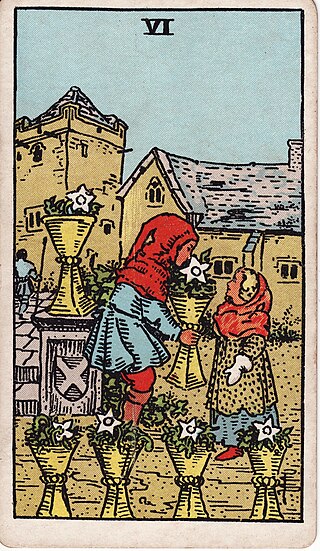
The Six of Cups is a Minor Arcana tarot card.
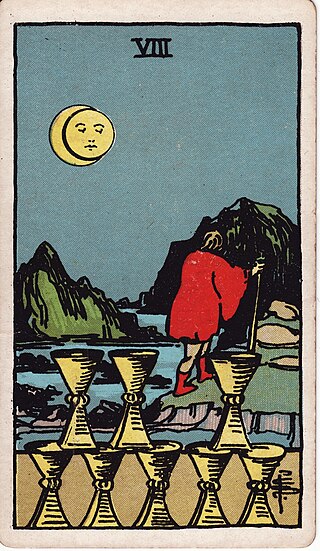
The Eight of Cups is a card used in Latin-suited playing cards, which include tarot decks. It is part of what tarot card readers call the "Minor Arcana"
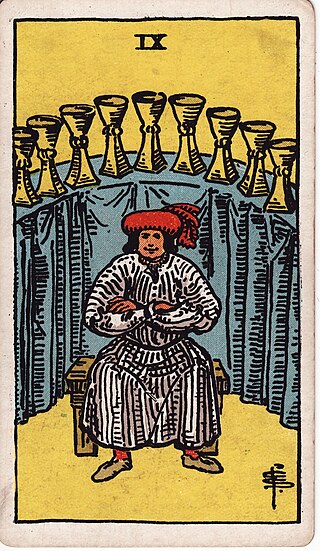
The Nine of Cups is a card used in Latin-suited playing cards which include tarot decks. It is part of what tarot card readers call the "Minor Arcana".
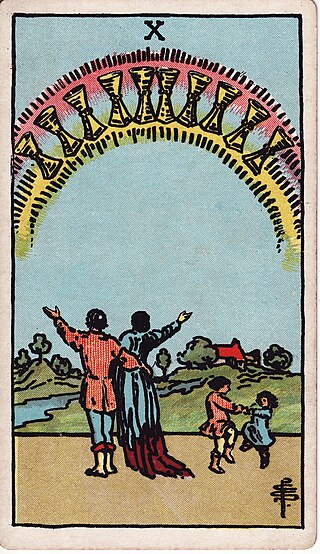
The Ten of Cups is a Minor Arcana tarot card.
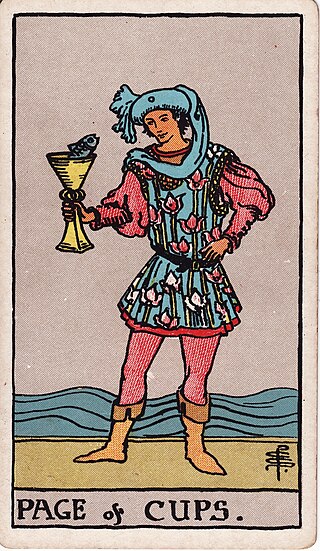
The Page of Cups is a card used in Latin-suited playing cards which include tarot decks. It is part of what tarot card readers call the "Minor Arcana"

The Knight of Cups is a card used in Latin-suited playing cards, including tarot decks. It is part of what tarot card readers call the "Minor Arcana".

The Queen of Cups is a card used in Latin-suited playing cards. It is the queen from the suit of cups. In Tarot, it is part of what tarot card readers call the "Minor Arcana".
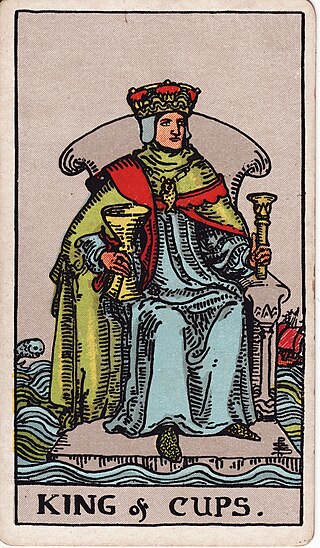
The King of Cups is a card used in suited playing cards, which include tarot decks. It is part of what esotericists call the Minor Arcana.

Two of Cups is a Minor Arcana tarot card.
The Three of Swords is the third card of the suit of swords. The suit is present in Italian, Spanish, and tarot decks.

Ace of Coins is a card used in Latin-suited playing cards, which include tarot decks. Tarot card readers call the coins suit "Pentacles," and include this card in their "Minor Arcana."

Troccas is a member of the Tarot family of card games. It is a four player game played in the Romansh speaking part of the canton Grisons of Switzerland. It is not known exactly how this game entered Switzerland but it is generally thought to have arrived from Italy during the 17th century.

The suit of cups is one of four suits of tarot which, collectively, make up the Minor Arcana. They are sometimes referred to as goblets and chalices. Like the other suits of the Minor Arcana, it contains fourteen cards: ace (one), two through ten, page, knight, queen and king. Historically, the suit represented the First Estate. Tarot cards were originally designed for card play and are still used throughout much of Europe to play various Tarot card games. However, in English-speaking countries, where the games are largely unknown, Tarot cards came to be utilized primarily for divinatory purposes. In modern card games, the equivalent suits are Hearts or Cups.
The Tarocco Piemontese is a type of tarot deck of Italian origin. It is the most common tarot playing set in northern Italy, much more common than the Tarocco Bolognese. The most popular Piedmontese tarot games are Scarto, Mitigati, Chiamare il Re, and Partita which are played in Pinerolo and Turin. This deck is considered part of Piedmontese culture and appeared in the 2006 Winter Olympics closing ceremony held in Turin. As this was the standard tarot pack of the Kingdom of Sardinia, it was also formerly used in Savoy and Nice before their annexation by France. Additionally, it was used as an alternative to the Tarocco Siciliano in Calatafimi-Segesta, Sicily. Outside of Italy, it is used by a small number of players in Ticino, Switzerland and was used by Italian Argentines.

Tarot games are card games played with tarot packs designed for card play and which have a permanent trump suit alongside the usual four card suits. The games and packs which English-speakers call by the French name tarot are called tarocchi in the original Italian, Tarock in German and similar words in other languages.
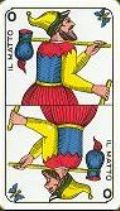
Scarto is a three player trick-taking tarot card game from Piedmont, Italy. It is a simple tarot game which can serve as an introduction to more complex tarot games. The name comes from the discarded cards that were exchanged with the stock, which is also the origin of the name for the Skat card game.

The Fool is one of the 78 cards in a tarot deck. Traditionally, it is the lowest of the 22 trump cards, in tarot card reading called the 22 Major Arcana. However, in tarot card games it developed to be not one of the trump cards but a special card, serving a unique purpose by itself. In later Central European tarot card games, it re-developed to now become the highest trump. As a consequence and with respect to his unique history, The Fool is usually an unnumbered card with a unique design; but sometimes it is numbered as 0 or more rarely XXII. Design and numbering-or-not to not clearly indicate its role as a trump or special card in the specific game.


















